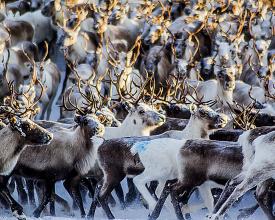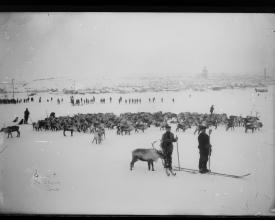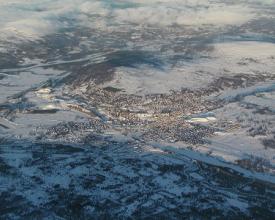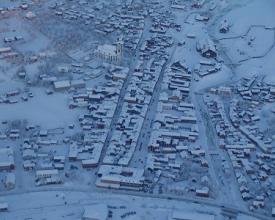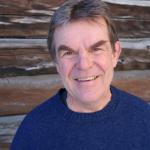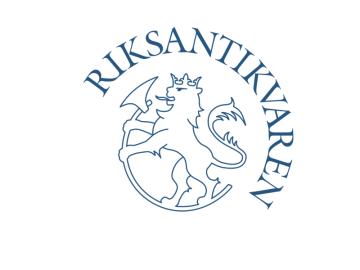
Intégration de la culture sami dans le récit de la ville minière de Røros et du patrimoine mondial de la Circonférence, Norvège
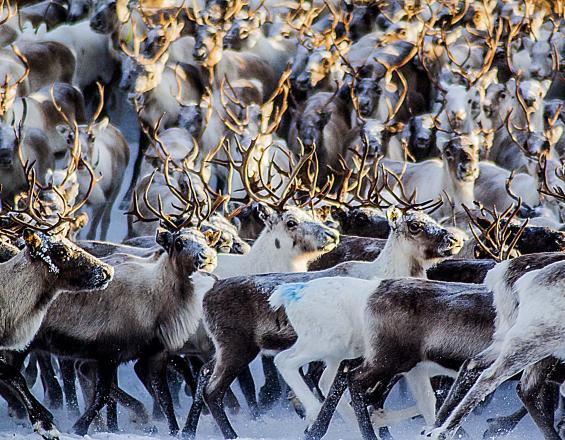
La ville minière de Røros a été inscrite sur la Liste du patrimoine mondial sur la base des critères (iii), (iv) et (v) en 1980. En 2010, la zone de patrimoine mondial a été étendue pour inclure les zones minières et les paysages agricoles autour de la ville minière de Røros, le fondoir Femundshytta et la "route de l'hiver". La zone appelée Circonférence, accordée à l'entreprise minière par la Couronne dano-norvégienne en 1646, a été ajoutée en tant que zone tampon : deux parcs nationaux, Femundsmarka et Forollhogna, et des parties de trois districts d'élevage de rennes samis s'y trouvent. En raison du manque de sources écrites et tangibles sur les pratiques samies, la reconnaissance des connaissances environnementales samies et des stratégies de gestion coutumière des paysages a été limitée dans la description du site du patrimoine mondial. Depuis l'extension, un processus a été lancé au niveau de la gestion pour inclure la culture samie dans l'interprétation du site, en mettant l'accent sur le musée de Røros, qui fait également office de centre du patrimoine mondial de Røros et de la Circonférence.
Contexte
Défis à relever
L'histoire de Røros et de la Circonférence en tant que site du patrimoine mondial repose sur son passé de ville minière qui s'étend sur plus de 333 ans (1644-1977) et sur les structures architecturales traditionnelles en bois qui ont été préservées. Cependant, l'élevage de rennes par les Samis est une pratique qui date d'avant les usines de cuivre de la région. La compréhension et la relation historique des Samis avec l'environnement à Røros et dans la Circonférence ne sont pas reconnues dans ce récit officiel, ce qui a un impact sur les droits fonciers des communautés samies ainsi que sur la continuité de leurs pratiques culturelles en relation avec l'environnement naturel.
Emplacement
Traiter
Résumé du processus
Le processus d'intégration de la culture samie dans le récit de la ville minière de Røros et de la Circonférence s'inscrit dans un processus beaucoup plus large de reconnaissance des droits des peuples autochtones samis. Røros, en tant que site du patrimoine mondial, attire l'attention du public et représente un cas important. Certaines étapes importantes de ce processus en cours sont présentées ici, montrant à la fois les approches et les résultats vers la reconnaissance des valeurs patrimoniales des Samis. L'inclusion d'un représentant des peuples autochtones au sein du Conseil de gestion du patrimoine mondial (BB1) a permis aux Samis de faire entendre leur voix dans la prise de décision concernant leurs territoires situés à l'intérieur du bien du patrimoine mondial. Parallèlement, l'intégration des perspectives des peuples autochtones dans l'interprétation de Røros (BB2) a été possible grâce à la création d'un poste de chercheur sami au musée de Røros, qui fait également office de centre du patrimoine mondial. De plus, l'octroi à la municipalité de Røros du statut de zone de gestion samie pour la langue et la culture a permis l'utilisation de la langue samie dans la signalisation du bien du patrimoine mondial (BB4). Un espace de dialogue sur l'inclusion des valeurs samies a été créé lors de l'élaboration du nouveau plan de gestion (BB3), renforçant l'idée de leur inclusion dans le récit du patrimoine mondial à l'avenir.
Blocs de construction
Représentant des populations autochtones au Conseil de gestion du patrimoine mondial
Le Conseil de gestion du patrimoine mondial a été créé en 2012 et est composé de 8 membres représentant les principaux groupes de parties prenantes du bien du patrimoine mondial : 5 maires des 5 municipalités - Røros, Tolga, Holtålen, Engerdal et Os -, 1 représentant de chacun des 2 comtés - Trøndelag et Innlandet (niveau régional) - et 1 représentant du Parlement sami. Le président exerce ses fonctions pendant deux ans et peut être réélu. Le coordinateur du patrimoine mondial fait office de secrétaire du conseil. En outre, il y a 6 observateurs : le directeur de Destination Røros, le directeur du musée de Røros, le directeur du musée de Nord-Østerdal (3 municipalités), le directeur de la municipalité de Røros, le responsable du patrimoine culturel de Røros et le responsable du site du parc national de Femundsmarka qui représente les deux parcs nationaux et les gouverneurs des deux comtés. Le conseil se réunit régulièrement (4 à 5 fois par an) et organise des excursions au cours desquelles il traite les dossiers proposés par le coordinateur, par les membres eux-mêmes et par d'autres parties prenantes. Le plan de gestion, le budget, les nouvelles propositions visant à renforcer les valeurs du site, la collaboration nationale et internationale et les auditions des différentes suggestions des directions et des départements sont discutés. Les décisions sont prises par consensus.
Facteurs favorables
Le parc national de Femundsmarka, situé dans la zone de la Circonférence, comptait un représentant du Parlement sami au sein de son propre conseil. Il s'agit d'un modèle pour le conseil de gestion du patrimoine mondial. En outre, en 2018, la municipalité de Røros est devenue une zone de gestion pour la langue sami, ce qui renforce également l'importance de la représentation du peuple sami dans les processus décisionnels du site du patrimoine mondial.
Leçon apprise
1) La sélection du représentant sami est effectuée par le Parlement sami. Ceci est important pour renforcer l'autorité et les liens avec le parlement.
2) La participation d'un représentant sami au conseil a influencé la façon dont le nouveau plan de gestion du patrimoine mondial intègre davantage la culture sami. Ceci est soutenu par l'administration et les politiciens des comtés, des municipalités et des musées qui étaient très conscients de la question de savoir comment la culture samie devait être intégrée dans le processus actuel du plan de gestion.
3) Le représentant sami est devenu un point focal pour les questions samies.
Intégrer le point de vue des populations autochtones dans l'interprétation du lieu patrimonial
Le musée est l'endroit où l'on peut en apprendre davantage sur Røros et la Circonférence. Le musée de Røros se compose de cinq sections principales, l'une consacrée aux bâtiments de Røros, l'autre à la culture samie, la troisième à la gestion de la conservation de la nature, la troisième à l'exploitation des mines et des carrières et la dernière au patrimoine mondial. Un poste permanent de chercheur sur les Samis a été créé en 2001. L'établissement du musée en tant que centre du patrimoine mondial de Røros et de la Circonférence en 2017 a permis d'élargir le récit du patrimoine mondial à la relation entre les Samis et le lieu qui existait déjà dans le musée. Dans cet espace, il est précisé que les Samis étaient présents dans la région avant le début de l'exploitation des mines de cuivre. La communauté sami a existé tout au long de l'histoire en tant que telle, mais aussi en interaction avec la société autour de la mine de cuivre. Ces interactions pouvaient être basées sur le commerce des rennes, l'artisanat, les peaux de rennes ou l'accueil des rennes appartenant aux propriétaires de la cuivrerie, aux commerçants et aux agriculteurs. Le paysage de la Circonférence a été, dans une certaine mesure, façonné en relation avec les rennes, et les Samis ont géré cette relation de manière durable.
Facteurs favorables
- Collection sur la culture samie (c'est-à-dire objets, archives visuelles) déjà existante dans le musée
- En 2012, le Parlement norvégien a décidé que tous les biens du patrimoine mondial devaient avoir un centre du patrimoine mondial.
- En 2017, le musée de Røros a commencé à travailler en tant que centre du patrimoine mondial de Røros et de la Circonférence.
Leçon apprise
Le financement du centre du patrimoine mondial de Røros a été un long processus. Il n'y a que deux personnes engagées spécifiquement pour la fonction de centre du patrimoine mondial au musée, même si l'ensemble du musée fonctionne d'une certaine manière comme un centre du patrimoine mondial. Pour financer ces deux personnes et leurs activités, l'État fournit 60 %, les comtés 20 % et les municipalités 20 %. Le financement régional de ces derniers 40 % a dû être organisé et approuvé par toutes les parties locales.
Utiliser l'élaboration du plan de gestion du patrimoine mondial comme un espace de dialogue
Le processus d'élaboration du nouveau plan de gestion du bien du patrimoine mondial a débuté en 2017, et plusieurs groupes y travaillent depuis trois ans (2017-2020). Le Conseil de gestion du patrimoine mondial dirige le processus, avec la collaboration du gestionnaire du patrimoine culturel de Røros, du représentant du peuple autochtone sami, des urbanistes des différentes municipalités et comtés situés dans le périmètre du bien du patrimoine mondial et de la zone tampon, et du directeur du musée de Røros. Des auditions et des réunions avec les conseils municipaux des cinq municipalités ont permis d'établir ce dialogue. Plus de 40 parties différentes ont été invitées aux audiences, notamment les comtés, les municipalités, les musées, les ONG, les personnes impliquées dans les plans de gestion, les propriétaires privés de terres situées dans le périmètre du bien du patrimoine mondial et le Parlement sami. Les Samis ont été impliqués de la même manière que les autres parties prenantes et ont compté avec des représentants au sein du Conseil du patrimoine mondial et du groupe administratif.
Facteurs favorables
- Le gouvernement a demandé à tous les sites norvégiens du patrimoine mondial d'élaborer de nouveaux plans de gestion.
- Le coordinateur du patrimoine mondial était chargé de la rédaction du précédent plan de gestion (2010) et avait la volonté et la mission d'élaborer un nouveau plan de gestion pour Røros.
Leçon apprise
1) Au cours de l'audition sur le nouveau plan de gestion, de nombreuses parties ont indiqué que la culture samie devrait être renforcée davantage qu'elle ne l'était déjà. La plupart des suggestions des différentes parties étaient de se concentrer davantage sur le renforcement des relations et des valeurs samies.
2) Renforcer l'idée d'inclure la culture samie dans la valeur universelle exceptionnelle du site du patrimoine mondial dans les années à venir. Cependant, l'État partie doit mener le processus. Certaines municipalités souhaitent que des zones actuellement situées dans la zone tampon (partie de la circonférence) soient intégrées au bien du patrimoine mondial (Narjodet, zone agricole, et Dragås-Eidet, qui est l'une des fonderies situées à l'extérieur de Røros).
3) Afin de travailler sur un pied d'égalité avec les différentes parties, aucune d'entre elles n'a fait l'objet d'un traitement particulier.
4) Afin d'intégrer les commentaires des différentes parties prenantes dans le plan de gestion, des auditions ont été organisées pour consulter sur les modalités d'élaboration du plan et, plus tard, pour consulter sur le plan lui-même.
Utilisation de la langue indigène dans la signalisation du lieu patrimonial
La municipalité de Røros est une zone de gestion de la langue et de la culture samie , un statut juridique qui permet d'utiliser la culture et la langue samie pour la communication publique, les écoles et les plans d'aménagement du territoire au niveau municipal. Le processus pour devenir une zone de gestion samie a commencé en 2015, et l'objectif de ce processus était de faire progresser la langue et la culture samie dans la municipalité. Le conseil municipal a délégué la mission à un comité politique, qui a présenté les résultats en novembre 2016. Le gouvernement a approuvé la demande en 2018. Aujourd'hui, 12 municipalités norvégiennes sont des zones de gestion de la langue et de la culture samies.
À Røros, la signalisation des lieux et des rues doit être traduite en langue samie au niveau du comté et de la municipalité. Un nom sami pour Røros sera également décidé. L'enseignement en langue samie est également dispensé à l'école primaire dans les municipalités de Røros et d'Engerdal. La langue samie est également utilisée dans la signature des courriels des fonctionnaires. Pour le processus de traduction et de dénomination, la municipalité nomme un comité qui suggère des mots et des noms. Les suggestions sont transmises au conseil municipal, qui envoie la proposition au Parlement sami. Le Parlement en discute lors d'une audition et, à l'issue de celle-ci, le conseil municipal décide définitivement des noms.
Facteurs favorables
La municipalité de Røros a été déclarée zone de gestion de la langue et de la culture samie en 2018.
Leçon apprise
1) Les non-Sámi réagissent de manière positive à la langue samie utilisée dans la signalisation, mais elle a été peu utilisée jusqu'à présent.
2) Certains mots sont difficiles à traduire, tous les concepts n'ont pas d'équivalents en langue samie, il y a donc encore des améliorations à apporter. Cependant, cela permet un processus d'apprentissage de la culture samie et des différences avec la langue norvégienne.
Impacts
L'intégration de la culture samie dans le récit du patrimoine mondial de Røros et de la Circonférence est un effort continu qui a porté ses fruits :
- La culture samie et la compréhension du paysage sont incluses dans l'interprétation du lieu patrimonial avec plusieurs expositions temporaires au musée de Røros, la dernière ayant eu lieu en 2017-2018. (https://verdensarvenroros.no/en/) ;
- Projet d'inclusion des valeurs samies dans la gestion du bien du patrimoine mondial (2021) ;
- Le plan de gestion pour 2019-2023 propose la création d'un nouveau poste permanent de conservateur spécialisé dans les bâtiments et les lieux samis (financé par le parlement sami) au musée de Røros.
Bénéficiaires
Communautés locales samies, 5 municipalités du site du patrimoine mondial : Røros, Tolga, Holtålen, Engerdal et Os, comtés d'Innlandet et de Trøndelag
Objectifs de développement durable
Histoire
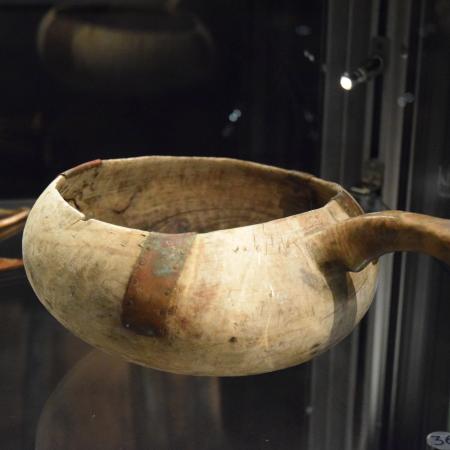
La région des Røros Sámi s'étend de Meråker, au nord, à Engerdal, au sud, et à Trollheimen, à l'ouest. L'élevage de rennes, la langue samie et l'artisanat sont des éléments clés de la culture samie. En 2017, le musée de Røros a inauguré l'exposition "Voix du Sud - La société samie de Røros et une nouvelle ère" à l'occasion du 100e anniversaire du premier congrès sami qui s'est tenu à Trondheim en 1917.
Pour le mouvement national norvégien, l'agriculture était le symbole de la nation, et la culture samie n'entrait pas dans ce cadre. Des théories scientifiques et des forces politiques puissantes ont abouti à de nouvelles lois qui ont profité aux agriculteurs au détriment des droits des Samis. L'existence des Samis a été sérieusement menacée et leur mode de vie nomade a été progressivement abandonné. La société samie subit alors de profonds changements.
Dans la partie la plus méridionale de la province de Sápmi en particulier, les zones de pâturage des rennes ont été sévèrement restreintes, et la langue et la culture samies ont été soumises à une pression extrême. L'impact des "lois lapones" et la réglementation de l'élevage de rennes à la fin du XIXe siècle ont incité de nombreux Samis à renforcer leurs droits. Un engagement politique fort a conduit au premier congrès national de la population samie à Trondheim en 1917. La création d'organisations samies au début du 20e siècle a été considérée comme un moyen important de faire évoluer la situation.
Pourtant, la lutte pour les droits des Samis est loin d'être terminée. La vie quotidienne de nombreux Samis est toujours affectée par d'anciennes lois et une majorité de la société continue de voir le monde d'un point de vue norvégien. Dans le même temps, beaucoup de choses se sont produites au cours des 30 dernières années, qui vont dans un sens plus positif, et la population samie de Norvège est désormais reconnue comme un peuple autochtone.
40 pièces ont été prêtées par le Norsk Folkemuseum (https://norskfolkemuseum.no/en). Les objets ont été collectés entre 1889 et 1950. Nombre d'entre eux témoignent d'un mode de vie nomade, qui a connu des changements spectaculaires en 1917. Les objets du musée folklorique n'avaient jamais été exposés dans la région où ils ont été collectés, et l'anniversaire était une bonne occasion de les montrer à la fois au peuple sami et aux autres habitants de la région.
L'exposition a été très bien accueillie par le public en général, et elle a été particulièrement significative pour les Samis, qui ont pu revoir les objets de leurs ancêtres sur leur lieu d'origine.
Site web : https://rorosmuseet.no/en/voices-from-the-south-online

